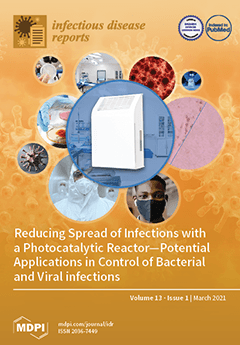The aim of this cross-sectional study was to investigate
Staphylococcus aureus nasopharyngeal carriage epidemiology in relation to other nasopharyngeal bacterial colonizers among sickle cell disease (SCD) children about five years into pneumococcal conjugate vaccine 13 (PCV-13) introduction in Ghana. The study involved bacteriological culture of nasopharyngeal swabs obtained from 202 SCD children recruited from the Princess Marie Louise Children’s Hospital.
S. aureus isolates were identified using standard methods and subjected to antimicrobial susceptibility testing using the Kirby-Bauer disc diffusion method. Cefoxitin-resistant
S. aureus isolates were screened for carriage of the
mecA,
pvl, and
tsst-1 genes using multiplex polymerase chain reaction. The carriage prevalence of
S. aureus was 57.9% (
n = 117), and that of methicillin-resistant
S. aureus (MRSA) was 3.5% (
n = 7). Carriage of the
mecA,
pvl, and
tsst-1 genes were respectively demonstrated in 20.0% (
n = 7), 85.7% (
n = 30), and 11.4% (
n = 4) of the cefoxitin-resistant
S. aureus isolates. PCV-13 vaccination (
OR = 0.356,
p = 0.004) and colonization with coagulase-negative staphylococci (CoNS) (
OR = 0.044,
p < 0.0001) each protected against
S. aureus carriage. However, none of these and other features of the participants emerged as a determinant of MRSA carriage. The following antimicrobial resistance rates were observed in MRSA compared to methicillin-sensitive
S. aureus: clindamycin (28.6% vs. 4.3%), erythromycin (42.9% vs. 19.1%), tetracycline (100% vs. 42.6%), teicoplanin (14.3% vs. 2.6%), penicillin (100% vs. 99.1%), amoxiclav (28.6% vs. 3.5%), linezolid (14.3% vs. 0.0%), ciprofloxacin (42.9% vs. 13.9%), and gentamicin (42.9% vs. 13.0%). The proportion of
S. aureus isolates that were multidrug resistant was 37.7% (
n = 46). We conclude that
S. aureus was the predominant colonizer of the nasopharynx of the SCD children, warranting the continuous monitoring of this risk group for invasive
S. aureus infections.
Full article






